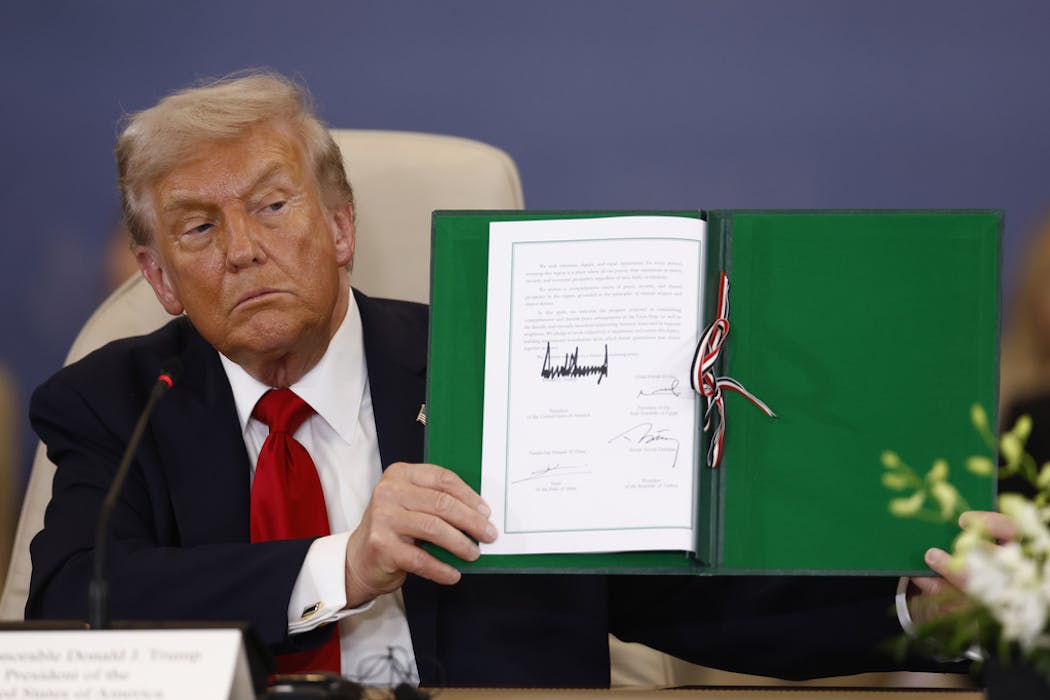Signature size and narcissism − a psychologist explains a long-ago discovery that helped establish t
Psychologist Richie Zweigenhaft found a link between signature size and self-esteem. A growing body of research has since established a link to narcissism as well.

For years, Donald Trump’s distinctive, large and bold signature has captured the public’s attention. Not only did it recently come to light that his signature appeared in a book that Jeffrey Epstein received for his 50th birthday, but it fits neatly alongside Trump’s long history of brash self-adulation. “I love my signature, I really do,” he said in a Sept. 30, 2025, speech to military leaders. “Everyone loves my signature.”
His signature also happens to be of particular interest to me, given my decades-long fascination with, and occasional academic research on, the connection between signature size and personal attributes.
A long-time social psychologist who has studied America’s elite, I made an unintentional empirical discovery as an undergraduate more than 50 years ago. The link that I found then – and that numerous studies have since echoed – is that signature size is related to status and one’s sense of self.
Signature size and self-esteem
Back in 1967, during my senior year of college, I was a work-study student in Wesleyan University’s psychology library. My task, four nights a week, was to check out books and to reshelve books that had been returned.
When students or faculty took books out, they were asked to sign their names on an orange, unlined card found in each book.
At some point, I noticed a pattern: When faculty signed the books out, they used a lot of space to sign their names. When students checked them out, they used very little space, leaving a lot of space for future readers.
So I decided to study my observation systematically.
I gathered at least 10 signatures for each faculty member and comparison samples of student signatures with the same number of letters in their names. After measuring by multiplying the height versus the width of the amount of space used, I found that eight of the nine faculty members used significantly more space to sign their names.
In order to test for age as well as status, I did another study in which I compared the signatures of blue-collar workers such as custodians and groundskeepers who worked at the school with a sample of professors and a sample of students – again matched for the number of letters, this time on blank 3-by-5-inch cards. The blue-collar workers used more space than the students but less than the faculty. I concluded that age was at play, but so was status.
When I told psychologist Karl Scheibe, my favorite teacher, about my findings, he said I could measure the signatures in his books, which he had been signing for more than a decade since his freshman year in college.
As can be seen in the graph, his book signatures mostly got bigger. They took a major leap in size from his junior year to his senior year, dipped a bit when he entered graduate school and then increased in size as he completed his Ph.D. and joined the Wesleyan faculty.
I did a few more studies, and published a few articles, concluding that signature size was related to self-esteem and a measure of what I termed “status awareness.” I found that the pattern held in a number of different environments, including in Iran – where people write from right to left.
The narcissism connection
Although my subsequent research included a book about the CEOs of Fortune 500 companies, it never crossed my mind to look at the signatures of these CEOs.
However, it did cross the minds of some researchers, 40 years later. In May 2013, I received a call from the editor of the Harvard Business Review because of the work I had done on signature size. They planned to run an interview with Nick Seybert, an associate professor of accounting at the University of Maryland, about the potential link between signature size and narcissism in CEOs.
While Seybert told me his research had not found direct evidence for a positive relationship between the two, the possibility of the connection he inferred nonetheless intrigued me.
So I decided to test this using a sample of my students. I asked them to sign a blank 3-by-5 card as if they were writing a check, and then I gave them a widely used 16-item narcissism scale.
Lo and behold, Seybert was right to deduce a link: There was a significant positive correlation between signature size and narcissism. Although my sample size was small, the link subsequently led Seybert to test two different samples of his students. And he found the same significant, positive correlation.
Others soon began to use signature size to assess narcissism in CEOs. By 2020, growing interest in the topic saw the Journal of Management publish an article that included signature size as one of five ways to measure narcissism in CEOs.
A growing field
Now, almost six years later, researchers have used signature size to explore narcissism in CEOs and other senior corporate positions such as chief financial officers. The link has been found not only in the U.S. but in countries including the United Kingdom, Germany, Uruguay, Iran, South Africa and China.
In addition, some researchers have studied the effect of larger versus smaller signatures on the viewers. For example, in a recent article in the Journal of Philanthropy, Canadian researchers reported on three studies that systematically varied the signature size of someone soliciting funds in order to see whether it affected the size of donations. It did. In one of their studies, they found that increasing the size of the sender’s signature generated more than twice as much revenue.
The surprising resurgence of research using signature size to assess narcissism leads me to a few conclusions.
For one, signature size as a measure of certain aspects of personality has turned out to be much more robust than I imagined as an observant undergraduate working in a college library back in 1967.
Indeed, signature size is not only an indicator of status and self-esteem, as I once concluded. It is also, as recent studies suggest, an indicator of narcissistic tendencies – the kind that many argue are exhibited by Trump’s big, bold signature.
Where this research is taken next is anyone’s guess, least of all for the person who noticed something intriguing about signature size so many years ago.
Richie Zweigenhaft does not work for, consult, own shares in or receive funding from any company or organization that would benefit from this article, and has disclosed no relevant affiliations beyond their academic appointment.
Read These Next
Black-market oil buyers will push Venezuela for bigger discounts following US seizure – starving Mad
Venezuela relies on the black-market oil trade for a large chunk of its revenue. US enforcement actions…
Polytechnic universities focus on practical, career-oriented skills, offering an alternative to trad
Polytechnic universities try to incorporate skills-based learning into education.
Tariffs 101: What they are, who pays them, and why they matter now
Tariffs are taxes on imports, but the costs don’t stay at the border.






